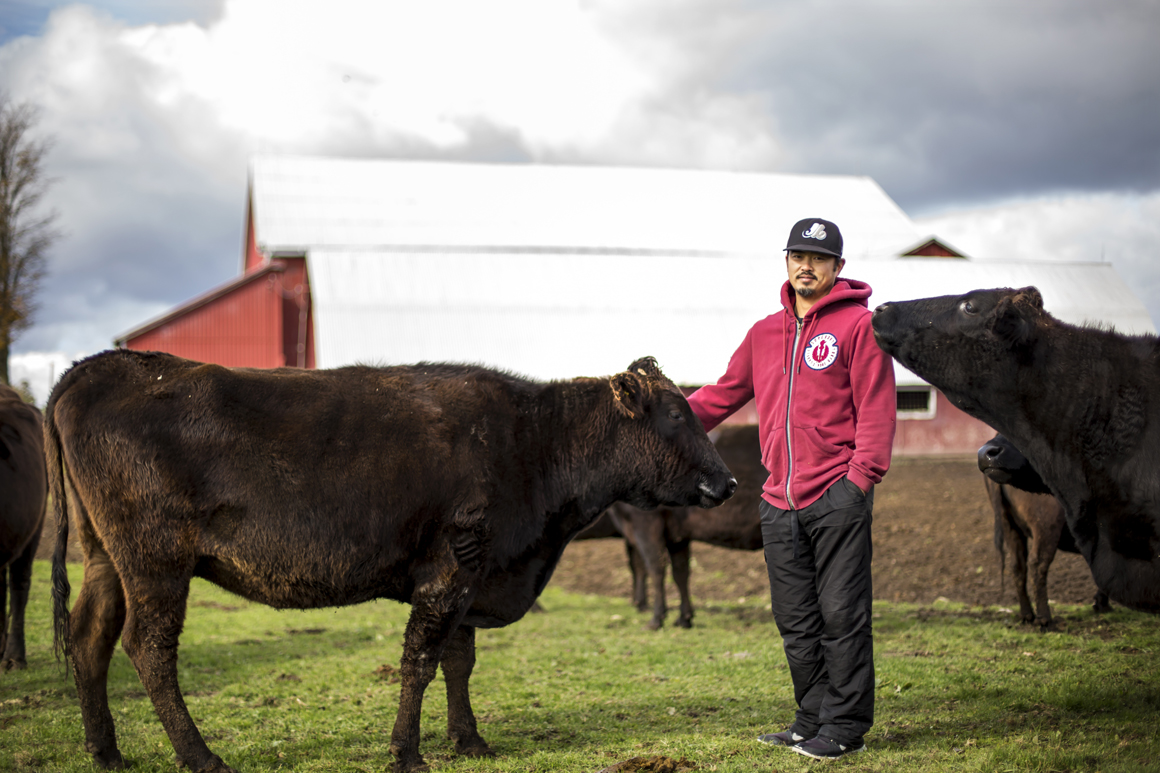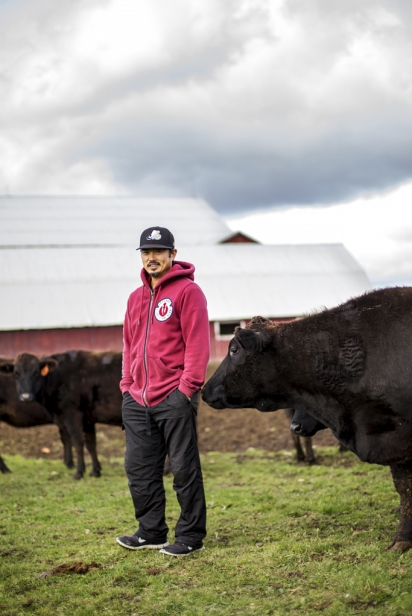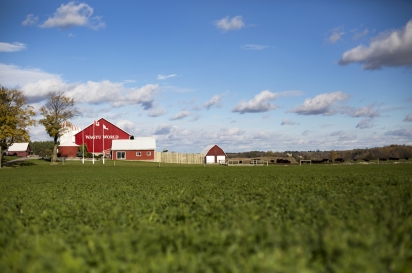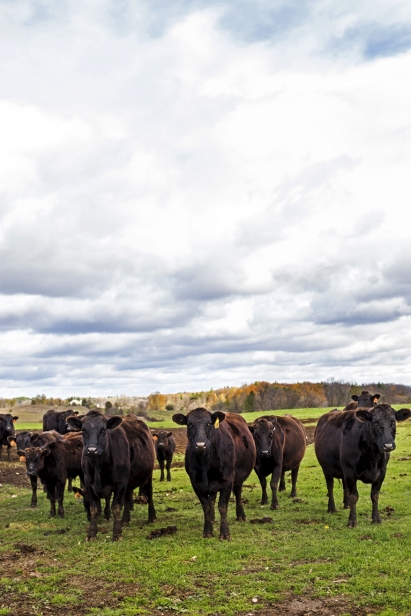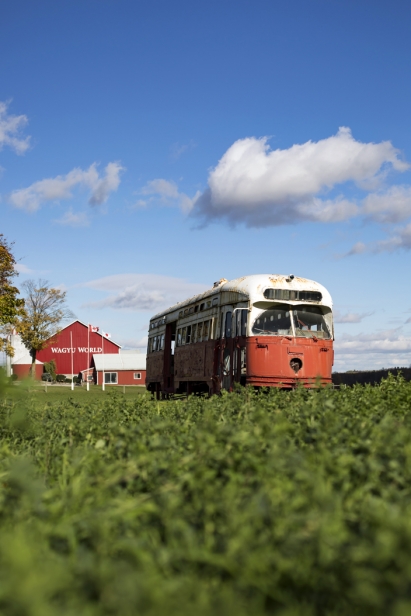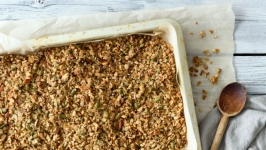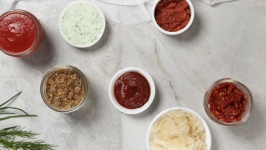Worldly Wagyu, From Ontario
Ken Kurosawatsu admits to serving Sleeman beer to his prized Wagyu cattle — “in the summer, to give them an appetite” — but he draws the line at massaging them.
“I worked in Japan for five years learning about Wagyu, and I never saw a massaged cow,” he says with a wry smile, in his farm office in Puslinch, Ont., mere metres from a lazy herd of jet black Wagyu bulls.
“It’s a good story though, it’s mythology. I always get asked about beer feeding and massaging. But the marbling of a cow is all genetics and feeding. You can’t massage it in.”
You can’t blame people for thinking there’s “a trick” to Wagyu, some arcane coddling that, at its best, produces a magic balance of spider-web marbling, texture and flavour. It’s the steak that can famously be cut with a fork, such is its buttery, grass-fed tenderness. (Kobe, the other famous name in Japanese beef, is a species of Wagyu, from Hyogo prefecture).
And Wagyu Sekai, Kurosawatsu’s family farm in Wellington County — formerly a producer of Holsteins — is the centre of a 25-year genetics experiment. Here, beef on the hoof is the star of the show. But backstage belongs to embryos and bull semen, frozen in liquid nitrogen and destined to travel the world.
When Kurosawatsu graduated high school in 1994, his father Yukio had taken an expensive gamble, buying four pregnant Wagyu cows for $50,000 each — among 200 head of cattle that had been recently exported from Japan (the last time it would ever happen as the country banned live cattle exports shortly after).
Eschewing college, Kurosawatsu headed to Japan to work for the company that sold his father his cows.
When he came back five years later, he was surprised to find his dad had two gambles in play. One was an old TTC Red Rocket streetcar, purchased at auction, bought with an eye to turning it into a restaurant serving Wagyu burgers on the farm. Alas, that was not to be, and Southern Ontarians were robbed of a genuine Wagyu burger-stand experience. (Those frozen Wagyu or Kobe patties you see at the supermarket? Likely a cheaper cross between Wagyu and Angus.)
But the other gamble paid off to global effect. Wagyu Sekai boasted the first Wagyu cattle born outside of Japan. Today, there are 160 bulls and cows, an estimated 50 to 60 of the cows being pregnant on the day we visited (a mass pregnancy test was scheduled for November).
The animals — sent to market at a rate of two every two weeks — appear on the menu at Jacobs & Co., a high-end steakhouse in Toronto. They're also on the menu of Waterloo catering company, My Sister's Kitchen, which sells them mainly to a clientele of affluent Chinese students, and they can be purchased at the Aberfoyle Farmers' Market in Puslinch and out of Kurosawatsu's own freezer.
But they are a secondary income stream for the farm. Some 70 per cent of Wagyu Sekai’s income is from exported genetics. The original 200 cattle’s progeny are closely followed. Ken’s bulls eventually make their way to a facility in Adel, Iowa. There,finally shipped home. Some pregnant cows are visited on the farm by specially-trained veterinarians who extract embryos.
From there, Kurosawatsu sends the genetic material to partners around the world. The latest, Rising Sun Wagyu in South Africa, will be exporting Sekai’s progeny to dining tables in the Middle East. Kurosawatsu takes these partnerships seriously. “We turn a lot of people away.
“I’ve been to South Africa, Argentina, Brazil, Australia and New Zealand. I like to work with my guys closely to make sure they’re doing the right job,” he says.
When he’s not en route elsewhere, he visits Japan often (recently to visit his in-laws in Kobe). “In Japan, all I do is eat Wagyu beef. All the way up and down, because I want to see how close our product is to the real deal.”
Pretty close, according to Danny McCallum, the executive chef of Jacobs, where a 12-ounce Sekai ribeye, at $252, is the most expensive cut, not actually imported from Japan, on the extensive Wagyu menu (a 16-ounce ribeye from Hyogo or Gifu prefectures is priced at $880).
“It’s been amazing, what his family has done,” says McCallum, who has carried Kurosawatsu’s product for seven years. “We have a lot of people who are on this special call list. We literally tell them when Ken’s meat is on the menu. We have one guy who flies in from New York just to come eat it.
“I mean, he can come here any time and eat Japanese beef. But he specifically wants Ken’s beef. I’m very honoured to have it in the restaurant.”
McCallum has made his own trips to Japan on beef missions. “We were lucky enough to go to Japan last year to be certified by the Kobe Beef Marketing and Promotion Association. We’re one of three restaurants in Canada certified to sell it. We have this Cow Shrine in the restaurant, these amazing Kobe statues they give you when you’re certified.”
There’s a definite pecking order for Wagyu. In North America, a so-called F-rating is used for anything below the rare 100 per cent full-blood (Sekai’s product). In Japan, there’s an A-scale, with A5 (the supreme sampling served at Jacobs) being the most desired. “A5 is unbelievable,” McCallum says.
People assume Kobe would be the most buttery of all, but McCallum says certain other varieties will beat it, with some being up to twice as marbled.
With Sekai-bred cattle on the table in so many countries, Kurosawatsu says he now has his eye on one big prize.
“The end game is to get into China,” he says. “It’s a work in progress. Some of the South American guys have buyers in China.”
Clara Wang of My Sister’s Kitchen thinks his prospects are good. “In China, one group is super rich. The people I know are from wealthy families, that’s why they can afford to come to Canada for school. It’s a very good market and many of them go to Japan these days, so they know Wagyu.” She discovered Wagyu Sekai at the farmers' market and was sold.
Beyond that, Kurosawatsu follows his dream of matching the meat produced by his mentors in Japan. “They have 70 years of practice. Their use of artificial insemination has evolved. If a bull turns out really well in Japan, pretty much the whole country ends up using that same bull.” He mentions one superstar Kobe bull, Yasufuku.
“Anything he breeds is considered A5. It doesn’t matter if you cross it with a dairy cow, a Jersey… you could cross it with a dog, it’d be A5,” he jokes.
Just a little genetics humour Wagyu farmers share. Don’t have a cow, dog lovers.
Wagyu Sekai
4157 Hwy. 6 South, Puslinch, Ont.
wagyuworld.com | 519.835.9647


